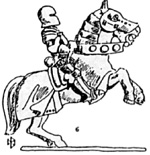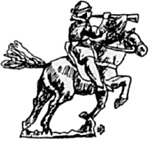when the muir men win their hay,
that the doughty Douglas bound him ride
into England to drive a prey.
 It is an interesting battle, Otterburn. Fought on 19th August 1388 and no doubt on countless wargames tables since then, the story has become a legend. Two armies, struggling to the death on a moonlit night over possession of a single knightly pennon; the mortally wounded Earl of Douglas, having his injury concealed so his men would not be disheartened; dark rumours of treachery and a knife in the back in the heat of the melee. Stirring stuff - no doubt about it.
It is an interesting battle, Otterburn. Fought on 19th August 1388 and no doubt on countless wargames tables since then, the story has become a legend. Two armies, struggling to the death on a moonlit night over possession of a single knightly pennon; the mortally wounded Earl of Douglas, having his injury concealed so his men would not be disheartened; dark rumours of treachery and a knife in the back in the heat of the melee. Stirring stuff - no doubt about it.
But the romance of the Otterburn legend has obscured the wider picture. Douglas' expedition was only part of a larger campaign, and one, as it happens, which is ideal for solo wargaming.
THE HISTORICAL BIT....
It seems that the Scots' decision to invade England in strength in 1388 was a popular one. They were still smarting from the humiliation of three years earlier, when the English had penetrated deep into Lothian, burning Edinburgh and the abbeys of Melrose, Dryburgh and Newbattle. By 1388, though, English defences were in disarray, King Richard II was quarrelling with his nobles, and northern England seemed ripe for retribution.
The Scots gathered at Jedburgh to formulate their plans. They were said to be 40,000 strong, though this must be a very generous estimate.
Here the Scots army divided, part heading directly south under the Earl of Douglas, while the main body, led by the Earl of Fife (King Robert II's second son) and Archibald Douglas (the Grim), Lord of Galloway, moved further west to cross into Cumberland.
Though the fact that this split occurred is not in doubt, the reasons for it are less clear cut. Froissart says that it was a deliberate strategy, to prevent the English from raiding into the Scots' East March whilst their army was all in the west. Wyntoun, on the other hand, maintains that Douglas struck out recklessly, with just his close supporters and with no clear plan except to get to grips with the enemy. We'll never know which is the truth (though it may be found somewhere between the two versions), but we do know that Douglas, with perhaps 300 - 400 spears and 2,000 infantry and archers, all mounted, crossed into Tynedale and raided as far as Newcastle.
Here, it is said, Douglas indulged in a single combat with Henry Percy, eldest son of the Earl of Northumberland and known to posterity as 'Hotspur'. The Englishman came off worst in the combat and was unhorsed. To add insult to injury, Douglas tore Hotspur's pennon from its shaft and taunted him that he would hang it in his castle at Dalkeith as a trophy. Percy, bruised in body and pride, swore he would recover the pennon before the Scot crossed the border.
It could be that Hotspur had originally thought Douglas' force was just the vanguard of a larger army. However, on learning from scouts that this was not the case, he gathered his own forces and set off in pursuit. Douglas, meanwhile, retired at a leisurely pace, assaulting a castle at Ponteland in passing and pausing to lay siege to a small tower at Otterburn in Redesdale.
As drama unfolded in the east, across the Pennines matters progressed in a more businesslike manner. Fife's and Galloway's men made camp outside the walls of recently-improved Carlisle Castle, without wasting any time or energy trying to besiege the place. They frightened off a force of local levies without difficulty and proceeded to send out raiding parties to harry the surrounding area.
The Earl of Fife, a prudent and capable commander, was not about to take any unnecessary risks.
Not so Hotspur. He was so eager to catch up with Douglas' retreating force that he didn't bother to wait for reinforcements. The Bishop of Durham, having raised a force of 8,000 men, arrived with them at Newcastle to find that the Percy had already set off in pursuit of the Scots.
Hotspur reached Otterburn as night fell. His men were fatigued, but the Scots appeared unprepared, so he decided to attack immediately. First, though, he ordered Sir Thomas Umphraville on a wide flank march to the right to ensure no Scots escaped, then he ordered the rest of his army to charge.
 It was not the walkover he expected. Either the Scots were prepared after all, or, as some chroniclers have it, the English blundered into the Scots' horse lines in the dark, giving Douglas' men time to sort themselves out. The Scots threw in a counter-attack, both frontally and against the English right flank, pushing them down the slope towards the River Rede.
It was not the walkover he expected. Either the Scots were prepared after all, or, as some chroniclers have it, the English blundered into the Scots' horse lines in the dark, giving Douglas' men time to sort themselves out. The Scots threw in a counter-attack, both frontally and against the English right flank, pushing them down the slope towards the River Rede.
In the dark and confusion, any longbowmen in the English ranks were useless. The battle became a bloody scrum in the moonlight. Douglas' banner was in the forefront of the fight, even after he fell, mortally wounded; he gave instructions that his fall should be concealed from his men, lest their morale should suffer. The English were pushed relentlessly back, until finally they broke, leaving the Scots masters of the field. Hotspur, his brother Ralph, and most Englishmen of note were captured.
Umphraville and his men found the Scots camp and pillaged it, but were forced to retreat when they found the battle lost. The Bishop of Durham, approaching next day with his force, encountered some of the bedraggled survivors of Hotspur's army and decided not to advance any further, leaving the Scots to escape with their booty and carrying their dead and wounded with them.
In the West March, Fife had also returned to Scotland, taking a great deal of booty and having suffered no casualties.
The rumour was soon to become current that Douglas was not killed fairly in battle, but had been stabbed in the back by one of his own men. The story persists to this day.
WARGAMING THE CAMPAIGN
The Otterburn campaign has lots of advantages from a wargamers point of view. It was fought over a comparatively small area, roughly a triangle with Newcastle, Berwick and Carlisle as the points, and we can assume that many of the combatants were familiar with the country on both sides of the border, due to their frequent raids. I think we can also assume that it would be relatively difficult to keep an army in being on their own side of the border for any length of time, but once across the border they could live off the land without worrying too much about its effect on the locals.
Details given in the chronicles of numbers of men are either sketchy or unlikely, so it is necessary to resort to a bit of guesswork. Assuming a figure scale of 50:1, I would go for the following:
SCOTS (Start at Jedburgh)
- 1200 spears (i.e. knights, men-at-arms, sergeants) 24 figures
800 archers 16 figures
12,500 others 250 figures
ENGLISH Hotspur (Newcastle)
- 600 spears 12 figures
8000 infantry 160 figures
Bishop of Durham (approaching from Durham) 8000 men 160 figures
Alnwick garrison 1000 men 20 figures
Cumberland levies (app. from Penrith) 2000 men 40 figures
All the spears are mounted, though often dismounted to fight. Scots knights were particularly fond of the battle-axe in hand-to-hand combat. Many of the infantry in the Scots army and Hotspur's force were mounted, but again would dismount to fight. We do not know what proportion of the English army were longbowmen; the chroniclers only mention them to point out how useless they were at Otterburn - assume 1 in 3 perhaps? The Cumberland levies put up a poor show; make them lowest morale class.
Assuming you classify your commanders:
- Fife was not inclined to take risks - count him as cautious.
Hotspur shows all the characteristics of a rash commander.
Walter Skirlawe, Bishop of Durham, would perhaps qualify as cautious also.
Douglas' character depends on whose version of events you believe. If he went off on his own looking for trouble, he should be rash. If, however, he was entrusted with carrying out a vital part of the Scots' strategy, he should count as bold.
The attached map is a matrix of movement points required to move troops from place to place. You could superimpose the matrix over a 'real' map of the area.
Suggested move distances are as follows:
- Army (say > 3000 men) 5 points per day.
Army with booty 3 points per day
Small force (<3000 men) 7 points per day
Small force with booty 5 points per day
Small force (All mounted) 9 points per day
Any group can force march an extra 50% overnight, but must remain stationary the following day to recover.
Any force can plunder enemy territory by remaining in one place and sending out raiding parties. After 5 days in one location, all booty in that area has been 'lifted' and the army must move on.
I have fought this campaign out once before. In my version, the Scots army split into two, more or less equal, parts. One part, led by Douglas, met with bloody defeat near Hexham; the other, under Fife, laid waste to Cumberland and beat the local levies in battle. The result, therefore, not too unlike the historical original, except for the outcome of the actual battle.
If I were to fight it again, I would make more of the rivalry between Douglas and Fife. These two actually represented two factions within the Scottish court. (The two differing accounts of Douglas' motivation were, in fact, the 'party line' of these two factions.) I think it would be interesting to award points to the two leaders to represent booty taken, enemy defeated and honours gained in combat. Their main consideration when making decisions would be to score points over their rival, rather than their enemy.
Back to Table of Contents -- Lone Warrior #130
Back to Lone Warrior List of Issues
Back to MagWeb Magazine List
© Copyright 2000 by Solo Wargamers Association.
This article appears in MagWeb (Magazine Web) on the Internet World Wide Web.
Other military history articles and gaming articles are available at http://www.magweb.com
